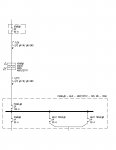Dee95
Member
- Location
- New Jersey
hi
I am checking an existing installation done by others.
I have a 30kVA 480-480/277V, Delta/WYE grounded transformer. This transformer is fed from a panel where circuit breaker is rated 60A, four #4 and it is 9 feet from this panel.
Secondary of the transformer has five #4 AWG conductor inside the conduit to a panel 8 feet away.
The panel that is connected to the secondary has a 100A main circuit breaker.
When I look at 450.3(B), main circuit breaker in the panel violates the code. Am I right, because it is less than 10 feet?
Thank you all...

I am checking an existing installation done by others.
I have a 30kVA 480-480/277V, Delta/WYE grounded transformer. This transformer is fed from a panel where circuit breaker is rated 60A, four #4 and it is 9 feet from this panel.
Secondary of the transformer has five #4 AWG conductor inside the conduit to a panel 8 feet away.
The panel that is connected to the secondary has a 100A main circuit breaker.
When I look at 450.3(B), main circuit breaker in the panel violates the code. Am I right, because it is less than 10 feet?
Thank you all...

